- Регистрация
- 17 Февраль 2018
- Сообщения
- 17 946
- Лучшие ответы
- 0
- Баллы
- 2 093
Offline
At a glance
Expert's Rating
Pros
Microsoft’s Surface Laptop Go 3 is a premium budget laptop, a contradiction in terms that tries and fails. Microsoft needs to rethink the concept.
Best Prices Today: Microsoft Surface Laptop Go 3
Retailer
Price

$799.99
View Deal

$799.99
View Deal
Price comparison from over 24,000 stores worldwide
Product
Price
Price comparison from Backmarket
Microsoft’s Surface Laptop Go 3 is here, again. Yep. It offers a 12th-gen Core processor, when the world is moving on to 13th-gen or soon 14th-gen chips. And that’s about all.
The Surface Laptop Go 3 is a budget laptop that busts your budget, with just a few improvements in memory capacity and the processor to tempt you to open your wallet. , this is still a compact 12-inch laptop, weighing about 2.5 pounds. But Microsoft has left this little laptop unchanged yet again — with its sub-1080p screen, to boot — while the world moves on.
, this is still a compact 12-inch laptop, weighing about 2.5 pounds. But Microsoft has left this little laptop unchanged yet again — with its sub-1080p screen, to boot — while the world moves on.
Microsoft Surface Laptop Go 3: Configurations
Microsoft’s Surface Laptop lineup and Microsoft’s Surface Laptop Go 3 are Microsoft’s mainstream laptops: the everyday laptop and the budget offering, respectively. What’s new in the Surface Laptop Go 3 versus the Surface Laptop Go 2? Just a spec bump to a 12th-gen Intel Core chip, a slight reworking of the chassis material, and a removal of the 4GB variant which hopefully no one previously bought.
The Surface Laptop Go 3 ships in two configurations for consumers. One has a Core i5-1235U, 8GB of RAM, and 256GB of SSD storage. The other boasts 16GB of RAM, but otherwise identical specifications. The 8GB version costs $799.99 while the 16GB version costs $999.99. Microsoft also ships the Surface Laptop Go 3 in four color options (Ice Blue, Sandstone, Platinum, Sage), only the Platinum option allows you the choice between the two configurations.
Weirdly, there is a cheaper alternative: the Surface Laptop Go 3 for Business, which swaps out the 256GB SSD for a 128GB UFS storage option. The cheapest model, a Core i5/8GB RAM/128GB UFS version, costs $749.99. Microsoft also sells business versions of the two consumer models for $899.99 and $1,099.99, respectively. Here, Microsoft adds a $1,249.99 option with 512GB of SSD storage, too.
Only the Business variants offer a choice of operating system (Windows 10 Pro or Windows 11 Pro.) Consumer versions ship with Windows 11 Home only.
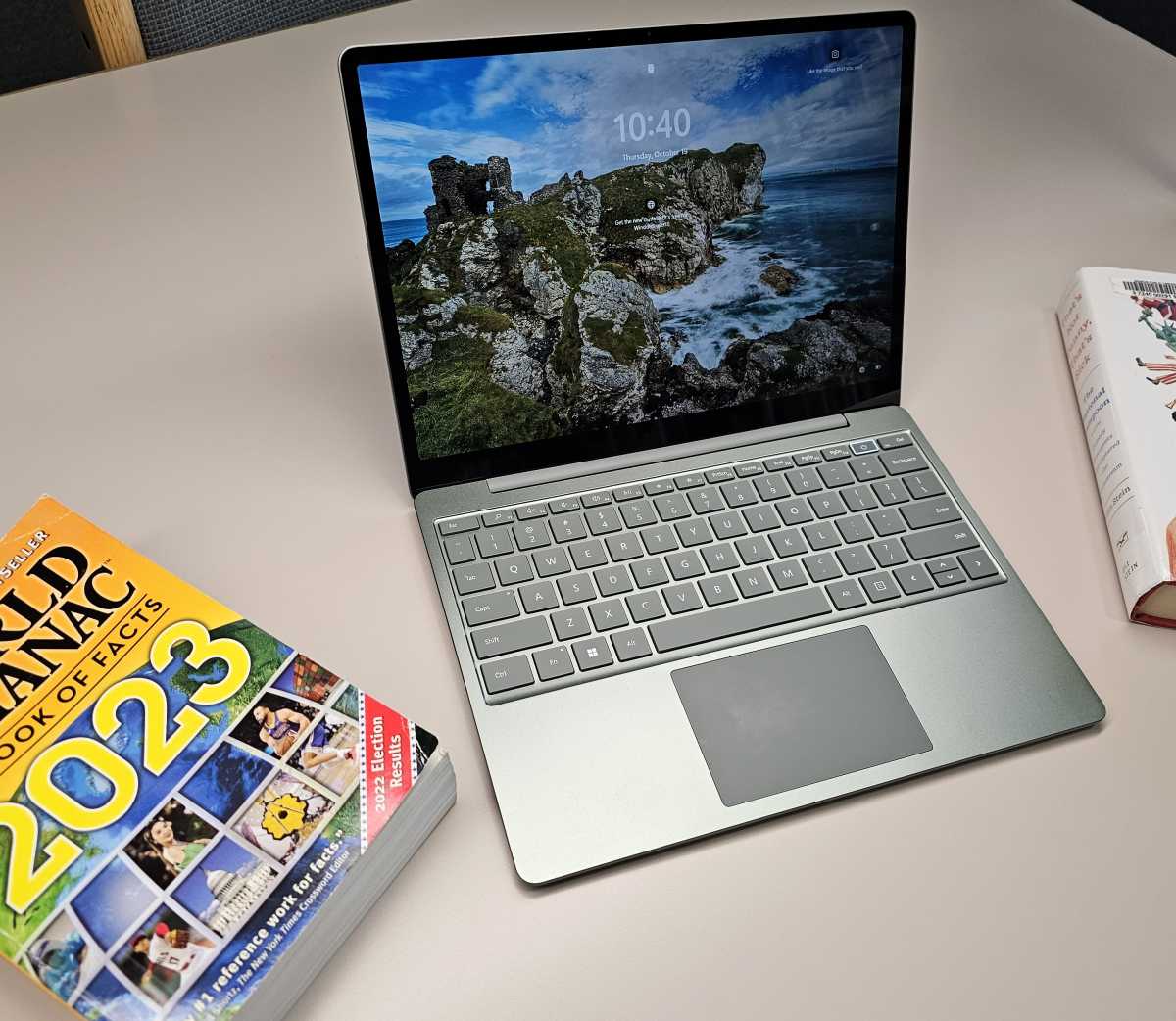
Mark Hachman / IDG
Surface Laptop Go 3: Specs
The thing I like best about the Surface Laptop Go 3, oddly, is its signature fingerprint reader. The Laptop Go series is the only one of Microsoft’s Surface devices to use an integrated fingerprint reader, which is surrounded by a small white neon strip that invites you to push it to get started. That’s a bit of a misnomer, as it turns out, as the Surface Laptop Go 3 begins its Windows 11 “out of the box experience” (OOBE) as soon as you open the lid without any further intervention.
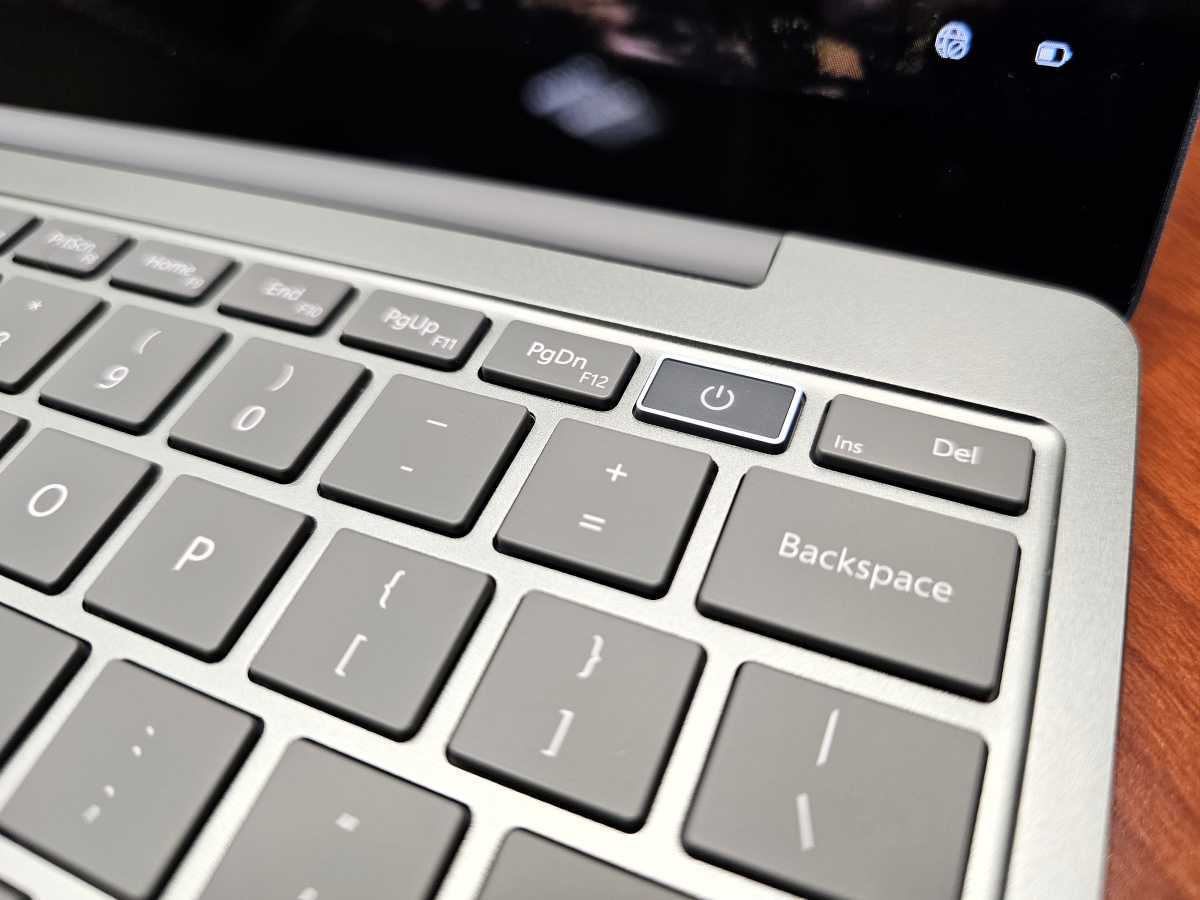
Mark Hachman / IDG
For someone new to the Surface Laptop Go 3, think of the laptop as Microsoft’s answer to the Chromebook. The lineup originally launched as a vehicle for Windows 11 in S Mode, an operating system Microsoft pivoted away from without much consumer support. But the aesthetic remains: very simple, streamlined, almost boring. The idea is for Microsoft to ship a minimized Surface experience — a challenge when the price tag pushes into the upper end of three figures.
What you can say about the Surface Laptop Go 3 is that it’s a truly compact, lightweight clamshell laptop. But it’s nearly exactly the same experience as the first two Surface Laptop Gos, too. That’s good for consistency’s sake, but not for the suspicion that Microsoft is merely treading water.
Surface Laptop Go 3: Display and ports
Let’s reiterate one of this laptop’s weaker points: the 1536×1024 display. On paper, it’s a hard sell: personally, I take a dim view of any Chromebook deals that offer less than a 1080p (1920×1084) screen, precisely because so many competitive offerings provide a higher-resolution screen. Any screen where you have to squint — I include 30Hz displays in this — fatigues your eyes.
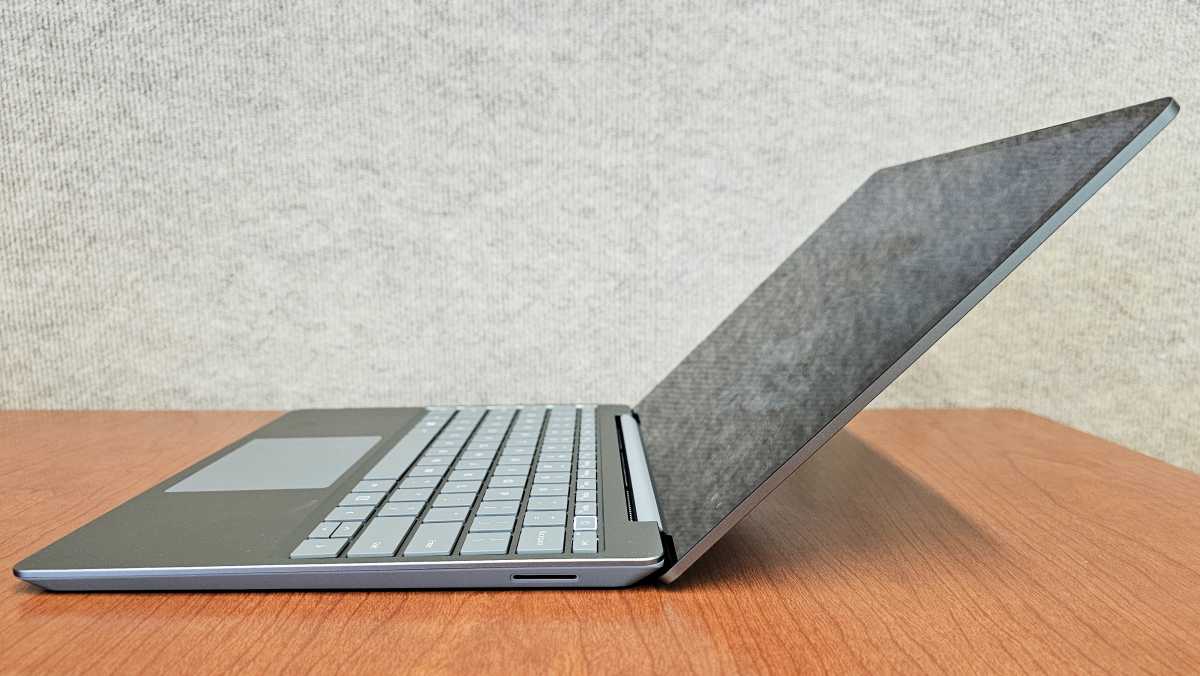
On the right side of the Microsoft Surface Laptop Go 3 is just a single Surface charging port.
Mark Hachman / IDG
Since the Surface Laptop Go 3 contains the same display and screen dimensions as the original Surface Laptop Go, I’ll refer you to the original Surface Laptop Go review for deeper scrutiny into how the screen holds up in real life. The bottom line: Surface Laptop Go 3’s pixels-per-inch count is comparable to that of a budget 15-inch 1080p notebook, such as an Asus VivoBook. So while the screen isn’t as detailed as I’d like, it’s not as bad as it appears on paper.
It’s also worth noting that one thing that doesn’t appear on a typical list of specifications is the screen brightness, which also affects eyestrain. The Surface Laptop Go 3 puts out about 344 nits, substantially above the 250-260 nits we consider to be comfortable for everyday, indoor use. The contrast ratio is also 1,000:1, also a plus.
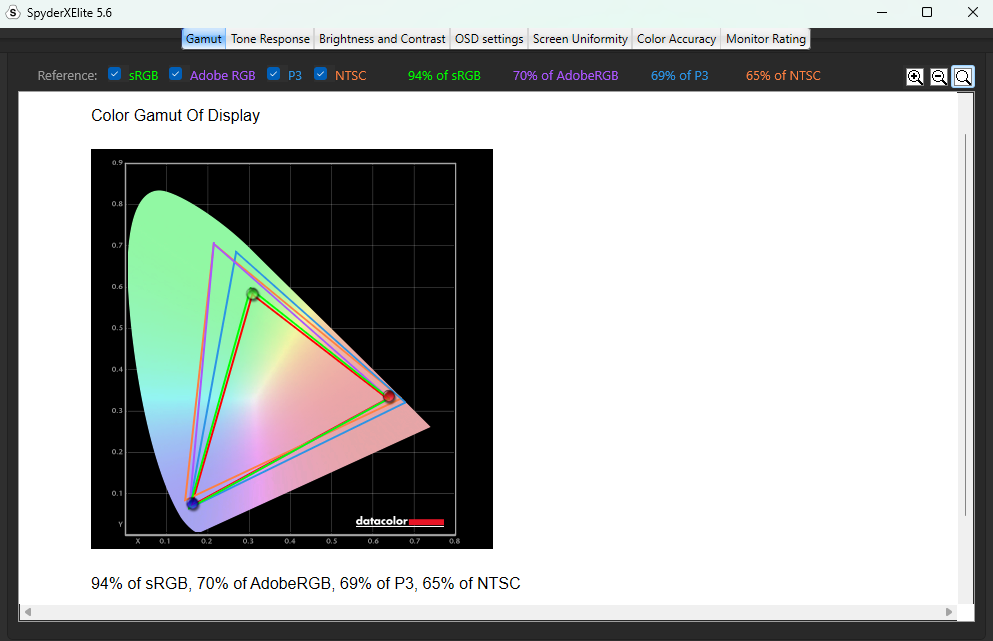
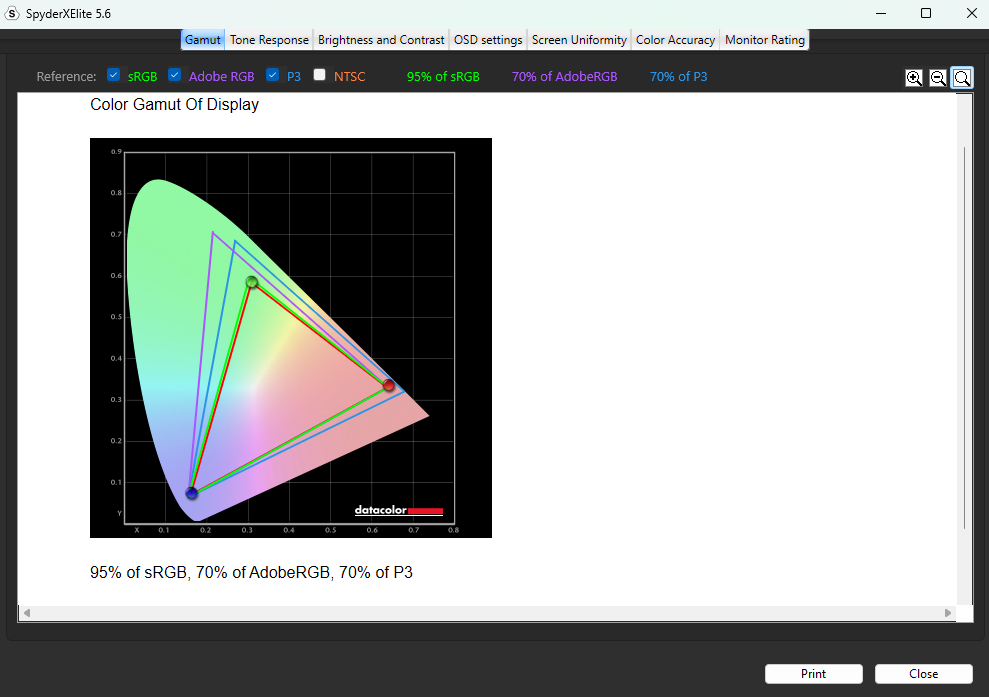
The Surface Laptop Go 3’s display color gamut in enhanced mode (left) and sRGB (right).
Otherwise, the Surface Laptop Go 2 is a traditional clamshell laptop, with a display that pushes back to about 45 degrees or slightly more. Not all budget laptops provide a touchscreen. The Surface Laptop Go 3 does, though it isn’t designed for inking.
I’ve since ditched my original Surface Dock, but Microsoft’s high-speed, power charging port did allow me to connect to both an external 4K display and a 1080p display, both. The Surface Laptop Go 3 connected to a single 4K display using a Thunderbolt dock (though a DisplayLink dock would provide better results, I’m sure). But that’s another point to consider: you can tether the Surface Laptop Go 3 and use an external display, instead.
A powered dock will also allow you to leave the Surface Laptop Go’s 39W charger in the box. Unlike other Surface Laptop chargers (such as the Surface Laptop Studio) the small, lightweight charger does not include a USB-A port for charging external devices.

Microsoft includes a vanilla USB-C and USB-A port on the side of the Surface Laptop Go 3. The USB-C port does charge devices, though.
Mark Hachman / IDG
Otherwise, the Surface Laptop Go 3 includes a standard USB-A port in the chassis for connecting a legacy device, such as a mouse or printer. There is a nice little bonus here: though the USB-A port puts out just 2.4W, the USB-C port puts out a hefty 8.7W. That amount of power allows you to fast-charge a smartphone, which feels like a feature most students would want.
Surface Laptop Go 3: A consistently decent keyboard
Microsoft has moved to a keyboard with a more rubbery feel, both in terms of the coating and the keys and the way they cushion your fingers through the keystroke. These keys still offer 1.3mm of key travel, pretty standard for the Surface lineup these days. The keyboard is consistent with the traditional Surface key layout, and not the updated keyboard of the Surface Laptop Studio 2.
I like the more spacious palm rests of the larger Surface keyboards, but you shouldn’t have anything to really complain about from a typing perspective. The keyboard isn’t backlit, however.
The trackpad is quite good, actually. Its clickable up to the very top regions of the trackpad, with a smooth finish that makes it easy to navigate. Really, most trackpads are uniformly good these days, but a consistent approach to quality is appreciated.
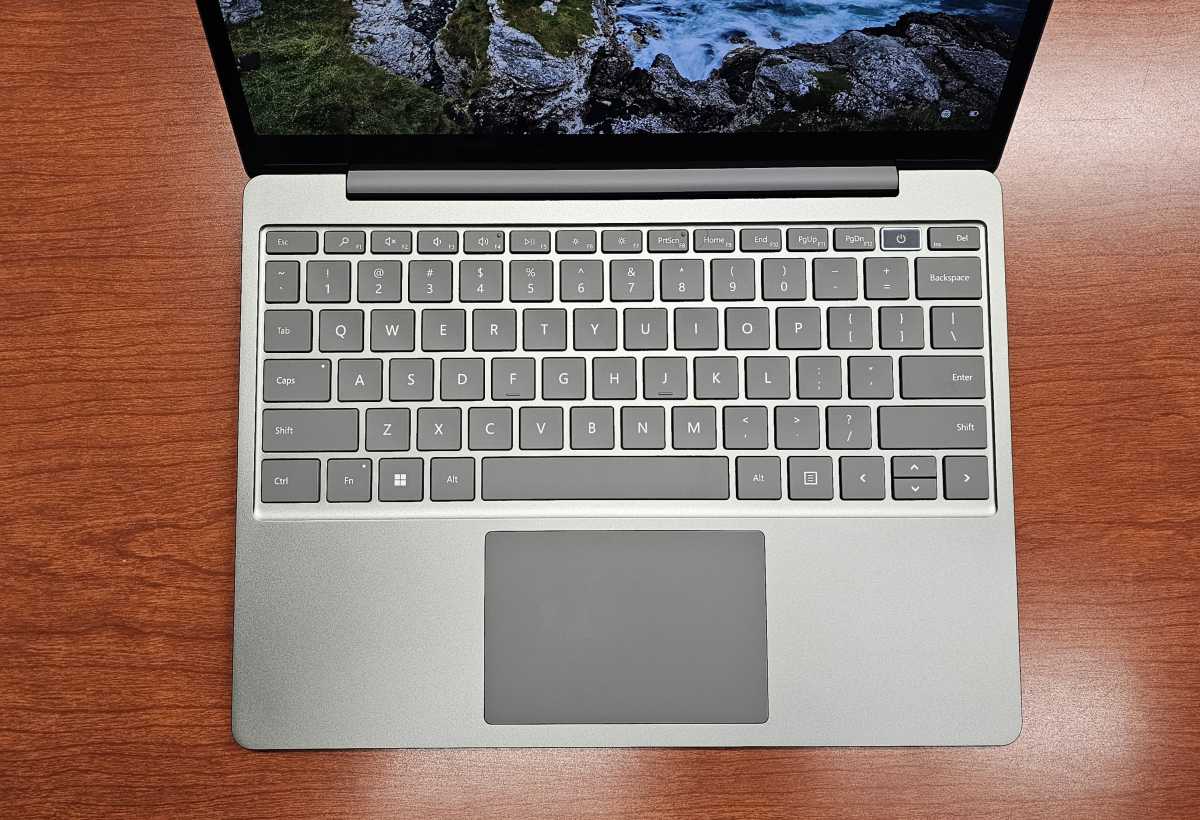
Mark Hachman / IDG
And yes, the signature feature of the Surface Laptop Go 3 is still its fingerprint reader. As noted above, it stands out: not only as the only device in the Surface lineup to use it, but because the lighting attracts the eye. It’s a quirky reminder that the Surface Laptop Go 3 can have personality; it just chooses not to. Don’t just go too overboard; this isn’t the mole that makes Cindy Crawford who she is.
The one advantage of a fingerprint reader is consistency; people’s fingerprints simply don’t change as readily as faces do with beards, makeup, different hairstyles and so on. Over time, fingerprint readers can accumulate grime. Both are hard to test effectively in a short review period. But Microsoft’s procedure for identifying yourself requires several (20 or so?) taps to establish your identity, than a single tap on subsequent logins to identify yourself. A nice feature is that pressing the power button with the correct fingerprint both powers on the Surface Laptop Go 3 as well as logs you in.
Surface Laptop Go 3: Webcam and audio
Unfortunately, the Surface Laptop Go lineup, including the latest model, never got the memo that the world has moved on to 1080p webcams. Microsoft again includes a 720p user-facing camera that does not include depth capabilities. This feels like a cost-cutting measure, but an increasingly unnecessary one in a world where cheap 1080p webcams are increasingly common.
There is no rear-facing camera, which isn’t particularly unusual.
I took sample shots with the Surface Laptop Go 3’s webcam. In good light, the 720p webcam records a nice image, with accurate color balance. But in dim light (I partially drew the shades for the second shot) the webcam image is grainy and not particularly clear. You’re not going to look good in a dim room with the Surface Laptop Go 3.


Two views of the Surface Laptop Go 3’s webcam. The second, in dimmer lights, gets noticeably grainy.
The speakers inside the Surface Laptop Go 3 are quiet, but clear. Having tested the Surface Laptop Studio 2 and its four loud, robust speakers, I was a little surprised by how comparatively quiet the Laptop Go 3’s speakers are. You’ll need a quiet room in order to hear everything. Microsoft provides a 3.5mm headphone jack if that’s not enough, however.
The Surface Laptop Go 3 also lacks the audio enhancements of its more expensive cousins. There’s simply nothing at all to improve the laptop’s sound, although Windows Sonic for Headphones is available once you plug in a pair of headphones or earbuds. All told, the Surface Laptop Go 3 follows the rule of laptop audio: the best aural experience comes through using headphones.
Surface Laptop Go 3: Performance
Unlike my initial experience with the Surface Laptop Studio 2, the Surface Laptop Go 3 never felt particularly laggy. Our review unit shipped with a Core i5 and 16GB of RAM, which we usually consider to be the preferred amount of memory within a laptop. Though we didn’t test the 8GB model, I’d say that amount of memory would be sufficient for a good experience; you’ll just be able to accomplish more with the16GB model.
The Surface Laptop Go 3 didn’t ship with the latest Windows 11 22H2/23H2 updates, which will eventually be known as the Windows 11 2023 Update. However, we download the latest updates as part of the laptop setup process, so we received most of the update save for Windows Copilot. It’s not clear whether that piece will arrive later, or if there is some hardware limitation holding it back.
Though the fan noise is minimal, we found that the Surface Laptop Go 3 will throttle itself over time, slowing itself down so it won’t overheat. I’ll discuss what I found below. Remember, too, that the Surface Laptop Go 3 ships at the lowest power/performance setting with the Windows 11 power slider. Turning that up to the highest, “Best performance” setting does increase the performance, but it doesn’t move the needle that much, We’ve highlighted those results with a black outline in our performance charts, below.
The key tradeoff for evaluating the Surface Laptop Go 3 is the traditional price-performance question, with Microsoft’s “Surface tax” attached. Microsoft has never simply tossed profits to the wind and priced the Surface lineup truly competitively; Microsoft always demands more money than its competitors do. This is especially risky in the budget space, where the Surface Laptop Go 3 plays… as do budget-minded competitors like Acer, and to a lesser extent Asus and HP.
Microsoft shipped the review unit the company provided at $999.99. The Laptop Go 3 also includes a 12.4-inch screen, which makes it both a small and pricey laptop — a bit of a rarity in the Windows world.
We chose to compare the $999 Microsoft Surface Laptop Go 3 with the $799 Asus ZenBook 14X OLED, the $329 Acer Aspire 3 , the $499 Acer Aspire 5 15, the $899 Acer Aspire Vero (2023), and the $1,199 Acer Swift Go 16 — yes, Acer dominates the budget laptop market. Also consider the $895 MSI Thin GF63, a gaming laptop which we don’t compare directly.
We use four key tests for evaluating performance: PCMark 10, which is a good general measure of everyday performance from web browsing to light gaming to CAD work; Cinebench R15, which measures how quickly the laptop’s CPU can complete a task; and Handbrake, an open-source app and benchmark which transcodes video both as a measure of performance as well as how well the laptop can thermally manage itself. The final performance test, 3DMark, measures how well the laptop performs in 3D applications like gaming.
In PCMark 10, the Surface Laptop Go 3 falls to nearly the bottom of the heap. Only by turning the performance up to maximum levels does it partially redeem itself.

The Surface Laptop Go 3 does not impress in overall PC use.
Mark Hachman / IDG
We use the Cinebench test to record how quickly the laptop can sprint through a given task — in this case, rendering an image.
We use a similar test, the R23 version, which can measure how fast the laptop can render a more complex scene, and how quickly it renders that scene after being looped for ten minutes. In this way we can tell if the laptop’s performance will drop over prolonged use. In this case, there is a decrease, but not much. Performance dropped from a score of 5,552 to 5,199, a difference of 6 percent.

Still, not the greatest score for the Surface Laptop Go 3.
Mark Hachman / IDG
We perform a similar test using the Handbrake app, which transcodes a video over time. While it was a practical task a few years ago, now it’s more of a benchmark that also serves as a thermal stress test. Still, this test requires a much longer time to complete.
Again, the Surface Laptop Go 3 didn’t really shine.

Is middle-of-the-pack performance acceptable? Perhaps, given its price.
Mark Hachman / IDG
Although its very doubtful that you would use the Surface Laptop Go 3 for gaming, we’d expect any child to try and sneak in a game of Roblox or Minecraft. If they do, they’ll find, again, average performance awaits.
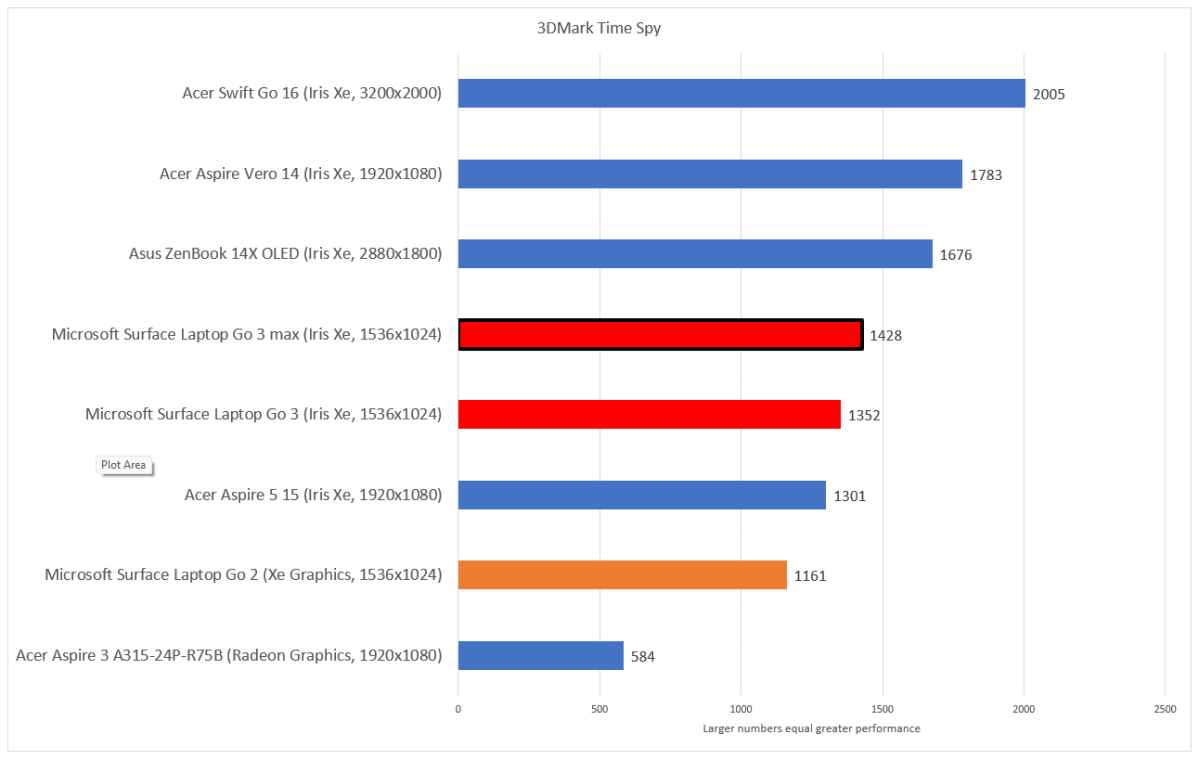
Yet again, cheaper notebooks outperform the Surface Laptop Go 3.
Mark Hachman / IDG
We also use one more test: battery life, where set the laptop at a fixed brightness, then loop a 4K video over and over until the laptop runs out of battery. In this test, Microsoft usually performs well, and here the Surface Laptop Go 3 lives up to its reputation, mainly.
Note that the compact size of the Surface Laptop Go 3 does make it useful for trains and planes, where work space is at a premium.
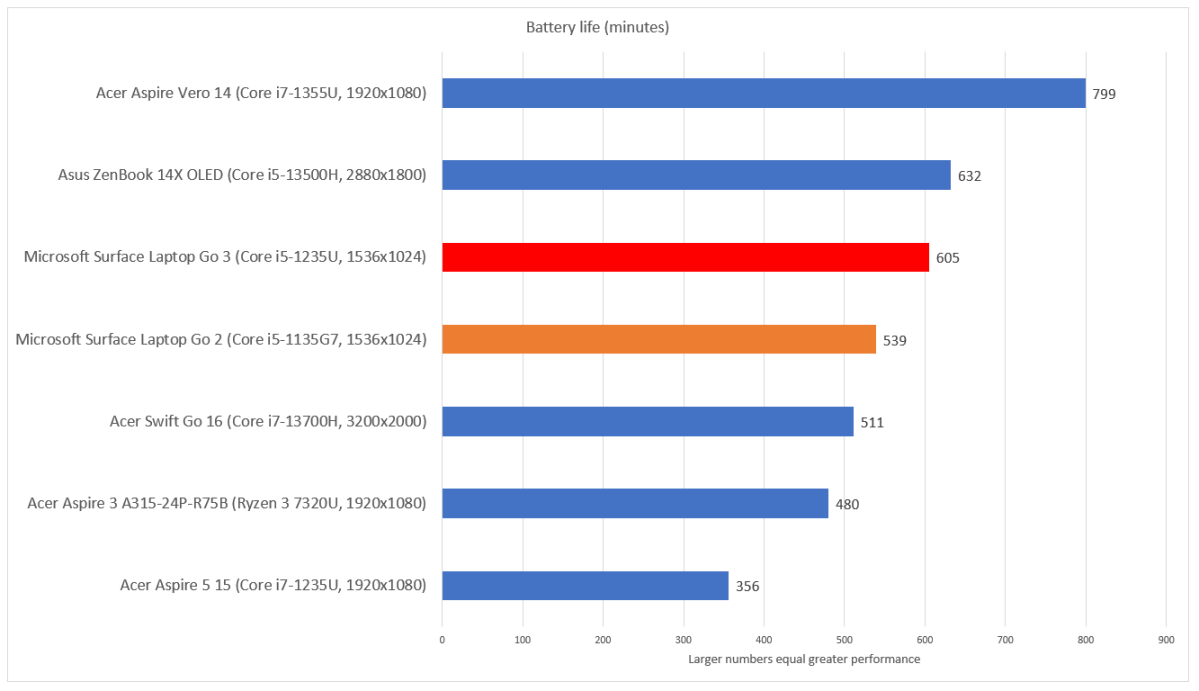
The Microsoft Surface Laptop Go 3 lasts about ten hours in our battery rundown test.
Mark Hachman / IDG
Surface Laptop Go 3: Should you buy it?
We don’t test an enormous variety of budget laptops, but it’s pretty clear that the Surface Laptop Go 3 is too overpriced for what it offers. Consider the Asus ZenBook 14X OLED: the screen is enormously better at 2880×1800 (with an OLED to boot), and that laptop clearly outperforms the Surface Laptop Go 3 in every facet, even accounting for the more memory of the Surface Laptop Go 3. The Aspire Vero is closest, price-wise, and it does too.
By itself, the Microsoft Surface Laptop Go 3 isn’t that bad. But, comparatively, there are far better options. Microsoft may have to reconsider its strategy here; either compete on price or upgrade the Surface Laptop Go’s components to offer some sort of advantage over the competition. For now, there’s little reason to buy it.
Laptops
Expert's Rating
Pros
- Bright screen
- Useful fingerprint reader
- Good keyboard
- A sub-1080p screen looks more and more dated
- Expensive for what it offers
- Middling performance
Microsoft’s Surface Laptop Go 3 is a premium budget laptop, a contradiction in terms that tries and fails. Microsoft needs to rethink the concept.
Best Prices Today: Microsoft Surface Laptop Go 3
Retailer
Price

$799.99
View Deal

$799.99
View Deal
Price comparison from over 24,000 stores worldwide
Product
Price
Price comparison from Backmarket
Microsoft’s Surface Laptop Go 3 is here, again. Yep. It offers a 12th-gen Core processor, when the world is moving on to 13th-gen or soon 14th-gen chips. And that’s about all.
The Surface Laptop Go 3 is a budget laptop that busts your budget, with just a few improvements in memory capacity and the processor to tempt you to open your wallet.
 , this is still a compact 12-inch laptop, weighing about 2.5 pounds. But Microsoft has left this little laptop unchanged yet again — with its sub-1080p screen, to boot — while the world moves on.
, this is still a compact 12-inch laptop, weighing about 2.5 pounds. But Microsoft has left this little laptop unchanged yet again — with its sub-1080p screen, to boot — while the world moves on.Microsoft Surface Laptop Go 3: Configurations
Microsoft’s Surface Laptop lineup and Microsoft’s Surface Laptop Go 3 are Microsoft’s mainstream laptops: the everyday laptop and the budget offering, respectively. What’s new in the Surface Laptop Go 3 versus the Surface Laptop Go 2? Just a spec bump to a 12th-gen Intel Core chip, a slight reworking of the chassis material, and a removal of the 4GB variant which hopefully no one previously bought.
The Surface Laptop Go 3 ships in two configurations for consumers. One has a Core i5-1235U, 8GB of RAM, and 256GB of SSD storage. The other boasts 16GB of RAM, but otherwise identical specifications. The 8GB version costs $799.99 while the 16GB version costs $999.99. Microsoft also ships the Surface Laptop Go 3 in four color options (Ice Blue, Sandstone, Platinum, Sage), only the Platinum option allows you the choice between the two configurations.
Weirdly, there is a cheaper alternative: the Surface Laptop Go 3 for Business, which swaps out the 256GB SSD for a 128GB UFS storage option. The cheapest model, a Core i5/8GB RAM/128GB UFS version, costs $749.99. Microsoft also sells business versions of the two consumer models for $899.99 and $1,099.99, respectively. Here, Microsoft adds a $1,249.99 option with 512GB of SSD storage, too.
Only the Business variants offer a choice of operating system (Windows 10 Pro or Windows 11 Pro.) Consumer versions ship with Windows 11 Home only.

Mark Hachman / IDG
Surface Laptop Go 3: Specs
- Display: 12.4-inch (1536×1024, 148 PPI) 10-point multitouch PixelSense display
- Processor: Core i5-1235U
- Graphics: Iris Xe Graphics
- Memory: 8GB-16GB LPDDR4x (16GB as tested)
- Storage: 128GB (removable UFS), 256/512GB (removeable SSD) (256GB as tested)
- Ports: 1 USB-C 3.2 (display and charging), 1 USB-A 3.1, Surface Connect, 3.5mm audio jack
- Camera: 720p f2.0 (user-facing)
- Battery: 39.7 watt-hours (design); 40.3Wh (actual)
- Wireless: Wi-Fi 6 (802.11ax), Bluetooth 5.1
- Operating system: Windows 11 Home (consumer); Windows 11 Pro/Windows 10 Pro (business)
- Dimensions (inches): 10.95 x 8.12 x 0.62 inches
- Weight: 2.49 pounds
- Chassis: Anodized aluminum, with a polycarbonate resin base (30 percent post-consumer recycled content)
- Colors: Ice Blue, Sandstone, Platinum, Sage
- Price: Beginning at $799 ($999.99 as tested)
The thing I like best about the Surface Laptop Go 3, oddly, is its signature fingerprint reader. The Laptop Go series is the only one of Microsoft’s Surface devices to use an integrated fingerprint reader, which is surrounded by a small white neon strip that invites you to push it to get started. That’s a bit of a misnomer, as it turns out, as the Surface Laptop Go 3 begins its Windows 11 “out of the box experience” (OOBE) as soon as you open the lid without any further intervention.

Mark Hachman / IDG
For someone new to the Surface Laptop Go 3, think of the laptop as Microsoft’s answer to the Chromebook. The lineup originally launched as a vehicle for Windows 11 in S Mode, an operating system Microsoft pivoted away from without much consumer support. But the aesthetic remains: very simple, streamlined, almost boring. The idea is for Microsoft to ship a minimized Surface experience — a challenge when the price tag pushes into the upper end of three figures.
What you can say about the Surface Laptop Go 3 is that it’s a truly compact, lightweight clamshell laptop. But it’s nearly exactly the same experience as the first two Surface Laptop Gos, too. That’s good for consistency’s sake, but not for the suspicion that Microsoft is merely treading water.
Surface Laptop Go 3: Display and ports
Let’s reiterate one of this laptop’s weaker points: the 1536×1024 display. On paper, it’s a hard sell: personally, I take a dim view of any Chromebook deals that offer less than a 1080p (1920×1084) screen, precisely because so many competitive offerings provide a higher-resolution screen. Any screen where you have to squint — I include 30Hz displays in this — fatigues your eyes.

On the right side of the Microsoft Surface Laptop Go 3 is just a single Surface charging port.
Mark Hachman / IDG
Since the Surface Laptop Go 3 contains the same display and screen dimensions as the original Surface Laptop Go, I’ll refer you to the original Surface Laptop Go review for deeper scrutiny into how the screen holds up in real life. The bottom line: Surface Laptop Go 3’s pixels-per-inch count is comparable to that of a budget 15-inch 1080p notebook, such as an Asus VivoBook. So while the screen isn’t as detailed as I’d like, it’s not as bad as it appears on paper.
It’s also worth noting that one thing that doesn’t appear on a typical list of specifications is the screen brightness, which also affects eyestrain. The Surface Laptop Go 3 puts out about 344 nits, substantially above the 250-260 nits we consider to be comfortable for everyday, indoor use. The contrast ratio is also 1,000:1, also a plus.


The Surface Laptop Go 3’s display color gamut in enhanced mode (left) and sRGB (right).
Otherwise, the Surface Laptop Go 2 is a traditional clamshell laptop, with a display that pushes back to about 45 degrees or slightly more. Not all budget laptops provide a touchscreen. The Surface Laptop Go 3 does, though it isn’t designed for inking.
I’ve since ditched my original Surface Dock, but Microsoft’s high-speed, power charging port did allow me to connect to both an external 4K display and a 1080p display, both. The Surface Laptop Go 3 connected to a single 4K display using a Thunderbolt dock (though a DisplayLink dock would provide better results, I’m sure). But that’s another point to consider: you can tether the Surface Laptop Go 3 and use an external display, instead.
A powered dock will also allow you to leave the Surface Laptop Go’s 39W charger in the box. Unlike other Surface Laptop chargers (such as the Surface Laptop Studio) the small, lightweight charger does not include a USB-A port for charging external devices.

Microsoft includes a vanilla USB-C and USB-A port on the side of the Surface Laptop Go 3. The USB-C port does charge devices, though.
Mark Hachman / IDG
Otherwise, the Surface Laptop Go 3 includes a standard USB-A port in the chassis for connecting a legacy device, such as a mouse or printer. There is a nice little bonus here: though the USB-A port puts out just 2.4W, the USB-C port puts out a hefty 8.7W. That amount of power allows you to fast-charge a smartphone, which feels like a feature most students would want.
Surface Laptop Go 3: A consistently decent keyboard
Microsoft has moved to a keyboard with a more rubbery feel, both in terms of the coating and the keys and the way they cushion your fingers through the keystroke. These keys still offer 1.3mm of key travel, pretty standard for the Surface lineup these days. The keyboard is consistent with the traditional Surface key layout, and not the updated keyboard of the Surface Laptop Studio 2.
I like the more spacious palm rests of the larger Surface keyboards, but you shouldn’t have anything to really complain about from a typing perspective. The keyboard isn’t backlit, however.
The trackpad is quite good, actually. Its clickable up to the very top regions of the trackpad, with a smooth finish that makes it easy to navigate. Really, most trackpads are uniformly good these days, but a consistent approach to quality is appreciated.

Mark Hachman / IDG
And yes, the signature feature of the Surface Laptop Go 3 is still its fingerprint reader. As noted above, it stands out: not only as the only device in the Surface lineup to use it, but because the lighting attracts the eye. It’s a quirky reminder that the Surface Laptop Go 3 can have personality; it just chooses not to. Don’t just go too overboard; this isn’t the mole that makes Cindy Crawford who she is.
The one advantage of a fingerprint reader is consistency; people’s fingerprints simply don’t change as readily as faces do with beards, makeup, different hairstyles and so on. Over time, fingerprint readers can accumulate grime. Both are hard to test effectively in a short review period. But Microsoft’s procedure for identifying yourself requires several (20 or so?) taps to establish your identity, than a single tap on subsequent logins to identify yourself. A nice feature is that pressing the power button with the correct fingerprint both powers on the Surface Laptop Go 3 as well as logs you in.
Surface Laptop Go 3: Webcam and audio
Unfortunately, the Surface Laptop Go lineup, including the latest model, never got the memo that the world has moved on to 1080p webcams. Microsoft again includes a 720p user-facing camera that does not include depth capabilities. This feels like a cost-cutting measure, but an increasingly unnecessary one in a world where cheap 1080p webcams are increasingly common.
There is no rear-facing camera, which isn’t particularly unusual.
I took sample shots with the Surface Laptop Go 3’s webcam. In good light, the 720p webcam records a nice image, with accurate color balance. But in dim light (I partially drew the shades for the second shot) the webcam image is grainy and not particularly clear. You’re not going to look good in a dim room with the Surface Laptop Go 3.


Two views of the Surface Laptop Go 3’s webcam. The second, in dimmer lights, gets noticeably grainy.
The speakers inside the Surface Laptop Go 3 are quiet, but clear. Having tested the Surface Laptop Studio 2 and its four loud, robust speakers, I was a little surprised by how comparatively quiet the Laptop Go 3’s speakers are. You’ll need a quiet room in order to hear everything. Microsoft provides a 3.5mm headphone jack if that’s not enough, however.
The Surface Laptop Go 3 also lacks the audio enhancements of its more expensive cousins. There’s simply nothing at all to improve the laptop’s sound, although Windows Sonic for Headphones is available once you plug in a pair of headphones or earbuds. All told, the Surface Laptop Go 3 follows the rule of laptop audio: the best aural experience comes through using headphones.
Surface Laptop Go 3: Performance
Unlike my initial experience with the Surface Laptop Studio 2, the Surface Laptop Go 3 never felt particularly laggy. Our review unit shipped with a Core i5 and 16GB of RAM, which we usually consider to be the preferred amount of memory within a laptop. Though we didn’t test the 8GB model, I’d say that amount of memory would be sufficient for a good experience; you’ll just be able to accomplish more with the16GB model.
The Surface Laptop Go 3 didn’t ship with the latest Windows 11 22H2/23H2 updates, which will eventually be known as the Windows 11 2023 Update. However, we download the latest updates as part of the laptop setup process, so we received most of the update save for Windows Copilot. It’s not clear whether that piece will arrive later, or if there is some hardware limitation holding it back.
Though the fan noise is minimal, we found that the Surface Laptop Go 3 will throttle itself over time, slowing itself down so it won’t overheat. I’ll discuss what I found below. Remember, too, that the Surface Laptop Go 3 ships at the lowest power/performance setting with the Windows 11 power slider. Turning that up to the highest, “Best performance” setting does increase the performance, but it doesn’t move the needle that much, We’ve highlighted those results with a black outline in our performance charts, below.
The key tradeoff for evaluating the Surface Laptop Go 3 is the traditional price-performance question, with Microsoft’s “Surface tax” attached. Microsoft has never simply tossed profits to the wind and priced the Surface lineup truly competitively; Microsoft always demands more money than its competitors do. This is especially risky in the budget space, where the Surface Laptop Go 3 plays… as do budget-minded competitors like Acer, and to a lesser extent Asus and HP.
Microsoft shipped the review unit the company provided at $999.99. The Laptop Go 3 also includes a 12.4-inch screen, which makes it both a small and pricey laptop — a bit of a rarity in the Windows world.
We chose to compare the $999 Microsoft Surface Laptop Go 3 with the $799 Asus ZenBook 14X OLED, the $329 Acer Aspire 3 , the $499 Acer Aspire 5 15, the $899 Acer Aspire Vero (2023), and the $1,199 Acer Swift Go 16 — yes, Acer dominates the budget laptop market. Also consider the $895 MSI Thin GF63, a gaming laptop which we don’t compare directly.
We use four key tests for evaluating performance: PCMark 10, which is a good general measure of everyday performance from web browsing to light gaming to CAD work; Cinebench R15, which measures how quickly the laptop’s CPU can complete a task; and Handbrake, an open-source app and benchmark which transcodes video both as a measure of performance as well as how well the laptop can thermally manage itself. The final performance test, 3DMark, measures how well the laptop performs in 3D applications like gaming.
In PCMark 10, the Surface Laptop Go 3 falls to nearly the bottom of the heap. Only by turning the performance up to maximum levels does it partially redeem itself.

The Surface Laptop Go 3 does not impress in overall PC use.
Mark Hachman / IDG
We use the Cinebench test to record how quickly the laptop can sprint through a given task — in this case, rendering an image.
We use a similar test, the R23 version, which can measure how fast the laptop can render a more complex scene, and how quickly it renders that scene after being looped for ten minutes. In this way we can tell if the laptop’s performance will drop over prolonged use. In this case, there is a decrease, but not much. Performance dropped from a score of 5,552 to 5,199, a difference of 6 percent.

Still, not the greatest score for the Surface Laptop Go 3.
Mark Hachman / IDG
We perform a similar test using the Handbrake app, which transcodes a video over time. While it was a practical task a few years ago, now it’s more of a benchmark that also serves as a thermal stress test. Still, this test requires a much longer time to complete.
Again, the Surface Laptop Go 3 didn’t really shine.

Is middle-of-the-pack performance acceptable? Perhaps, given its price.
Mark Hachman / IDG
Although its very doubtful that you would use the Surface Laptop Go 3 for gaming, we’d expect any child to try and sneak in a game of Roblox or Minecraft. If they do, they’ll find, again, average performance awaits.

Yet again, cheaper notebooks outperform the Surface Laptop Go 3.
Mark Hachman / IDG
We also use one more test: battery life, where set the laptop at a fixed brightness, then loop a 4K video over and over until the laptop runs out of battery. In this test, Microsoft usually performs well, and here the Surface Laptop Go 3 lives up to its reputation, mainly.
Note that the compact size of the Surface Laptop Go 3 does make it useful for trains and planes, where work space is at a premium.

The Microsoft Surface Laptop Go 3 lasts about ten hours in our battery rundown test.
Mark Hachman / IDG
Surface Laptop Go 3: Should you buy it?
We don’t test an enormous variety of budget laptops, but it’s pretty clear that the Surface Laptop Go 3 is too overpriced for what it offers. Consider the Asus ZenBook 14X OLED: the screen is enormously better at 2880×1800 (with an OLED to boot), and that laptop clearly outperforms the Surface Laptop Go 3 in every facet, even accounting for the more memory of the Surface Laptop Go 3. The Aspire Vero is closest, price-wise, and it does too.
By itself, the Microsoft Surface Laptop Go 3 isn’t that bad. But, comparatively, there are far better options. Microsoft may have to reconsider its strategy here; either compete on price or upgrade the Surface Laptop Go’s components to offer some sort of advantage over the competition. For now, there’s little reason to buy it.
Laptops
